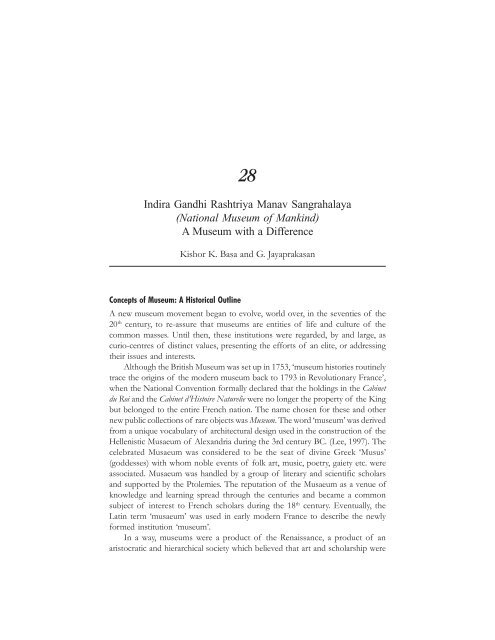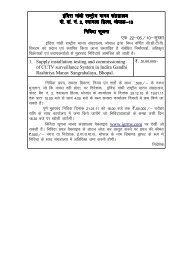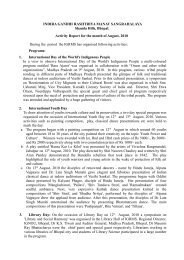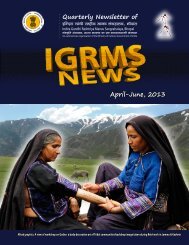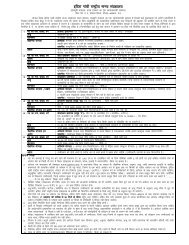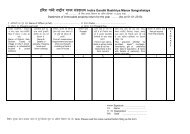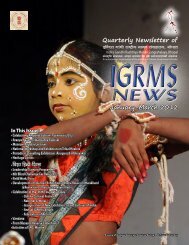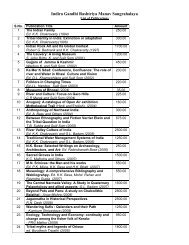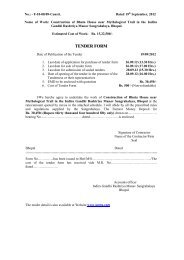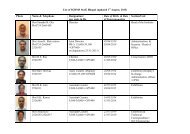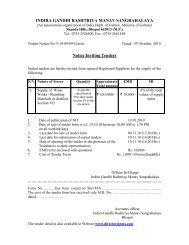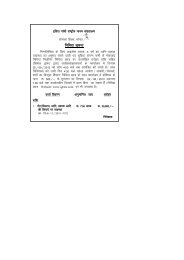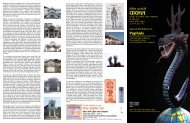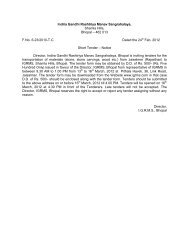Indira Gandhi Rashtriya Manav Sangrahalaya (National ... - IGRMS
Indira Gandhi Rashtriya Manav Sangrahalaya (National ... - IGRMS
Indira Gandhi Rashtriya Manav Sangrahalaya (National ... - IGRMS
You also want an ePaper? Increase the reach of your titles
YUMPU automatically turns print PDFs into web optimized ePapers that Google loves.
28<br />
<strong>Indira</strong> <strong>Gandhi</strong> <strong>Rashtriya</strong> <strong>Manav</strong> <strong>Sangrahalaya</strong><br />
(<strong>National</strong> Museum of Mankind)<br />
A Museum with a Difference<br />
Kishor K. Basa and G. Jayaprakasan<br />
Concepts of Museum: A Historical Outline<br />
A new museum movement began to evolve, world over, in the seventies of the<br />
20 th century, to re-assure that museums are entities of life and culture of the<br />
common masses. Until then, these institutions were regarded, by and large, as<br />
curio-centres of distinct values, presenting the efforts of an elite, or addressing<br />
their issues and interests.<br />
Although the British Museum was set up in 1753, ‘museum histories routinely<br />
trace the origins of the modern museum back to 1793 in Revolutionary France’,<br />
when the <strong>National</strong> Convention formally declared that the holdings in the Cabinet<br />
du Roi and the Cabinet d’Histoire Naturelie were no longer the property of the King<br />
but belonged to the entire French nation. The name chosen for these and other<br />
new public collections of rare objects was Museum. The word ‘museum’ was derived<br />
from a unique vocabulary of architectural design used in the construction of the<br />
Hellenistic Musaeum of Alexandria during the 3rd century BC. (Lee, 1997). The<br />
celebrated Musaeum was considered to be the seat of divine Greek ‘Musus’<br />
(goddesses) with whom noble events of folk art, music, poetry, gaiety etc. were<br />
associated. Musaeum was handled by a group of literary and scientific scholars<br />
and supported by the Ptolemies. The reputation of the Musaeum as a venue of<br />
knowledge and learning spread through the centuries and became a common<br />
subject of interest to French scholars during the 18 th century. Eventually, the<br />
Latin term ‘musaeum’ was used in early modern France to describe the newly<br />
formed institution ‘museum’.<br />
In a way, museums were a product of the Renaissance, a product of an<br />
aristocratic and hierarchical society which believed that art and scholarship were
<strong>Indira</strong> <strong>Gandhi</strong> <strong>Rashtriya</strong> <strong>Manav</strong> <strong>Sangrahalaya</strong> 277<br />
for a closed circle. In Europe and in most colonial territories, museums and art<br />
galleries began at a time when the people who controlled them had a contempt<br />
for the masses’ (Hudson 1977: 7). Many of the museums developed in the western<br />
world in the 18 th century had inherited this outlook, and remained as such for a<br />
long. The ethnological museums ‘invented’ by European colonizers in the 19 th<br />
century, in course of their expeditions to the rest of the world, had presented<br />
their collection of objects as either curio-items, or as proof of emphasis that the<br />
culture of colonized communities were ‘inferior’ or ‘peripheral’ to the technological<br />
achievements of Europe.<br />
The seventies of 20th century was a decade of crucial developments in the<br />
history of museums and museology all over the world. This was the period when<br />
independent countries, including India, began to settle down. New nationalism<br />
and cultural identities began to emerge among the liberated countries. In the<br />
newly independent countries, the role of museums began to firm-up during this<br />
period as important cultural centers for asserting national and regional identities.<br />
In the 1971 General Conference of the International Council of Museums<br />
(ICOM) held in France (at Grenoble), an African delegate from Benin, made a<br />
statement with considerable heat and vigour. ‘Museums’, he said, ‘were not<br />
integrated into the contemporary world and formed no real part of it. They were<br />
elitist, and of no use whatever to the majority of people; in all countries, they<br />
were obsolete; and they ought to disappear so that the public money could be<br />
spent to better purpose’. There were many takers of this passionate statement.<br />
The conclusion reached at the 1971 ICOM Conference was that the social,<br />
economic and cultural changes occurring in the world, particularly in many underprivileged<br />
regions, constitute a challenge to museology. The future historians of<br />
museums and museology may well decide that 1971 was the year in which it<br />
became obvious that there would have to be fundamental changes in the philosophy<br />
and aims of museums, and that the traditional attitudes were inadequate and<br />
obsolete in demonstrating the contemporary relevance of museum. It was felt<br />
that a museum should mould the consciousness of the communities it serves,<br />
link together the past and present. However, there was no suggestions that existing<br />
specialized museums should be closed down or abandoned, but, to meet the<br />
social needs, it was felt that there should be a gradual change in the outlook of<br />
curators and administrators, so that a steady progress towards ‘integrated museum’<br />
might be ensured. Integrated museum approach meant a realization that it exists<br />
to meet the needs of people, not merely to preserve what the French call the<br />
patrimone, the national cultural heritage’. (Hudson 1977:15).<br />
Birth of <strong>IGRMS</strong>: Initial Ideas and Concepts<br />
The birth of ‘<strong>National</strong> Museum of Man’ in India was a sequel of these<br />
developments. In the Calcutta session of the Indian Science Congress, held in<br />
1970, Sachin Roy, President of the Anthropology and Archaeology Section,
278 Multiple Heritage: Role of Specialised Museums in India<br />
emphasized the need of a ‘Museum of Man’ in India, in his presidential address.<br />
Roy was a senior museum professional from India and was also an ICOM member<br />
of that time. He had later (in 1972) published a book titled ‘Museum of Man in<br />
India: Problems and Prospects’ and also made an appeal to the then Prime Minister<br />
of India, to consider setting up a Museum of Man. His idea was holistic<br />
presentation of human creativities in Museum, by adopting an inter-disciplinary<br />
approach. It was recognized, by this time, ‘no single discipline was capable of<br />
understanding ‘man’ through its single-lens glass’. He felt that an ‘integrated<br />
museum approach’ would require co-operation between different types of<br />
museums, research institutes and fusion of disciplines, viz. anthropological,<br />
ecological, techno-economical, ideological, aesthetic, historical etc. ‘Museology,<br />
to be worthy of that name must embrace and show itself capable of absorbing all<br />
these different ways of looking at human activity. Many social scientists in India<br />
have supported the emerging trend of the integrated approach.<br />
The 10th General Conference of the ICOM held at Copenhagen (Denmark)<br />
in 1974 has recognised that ‘museums throughout are coming to regard themselves<br />
less and less as self-contained professional units and more as cultural centres for<br />
communities within which they operate’ (Hudson 1977). It was also resolved that<br />
the museum must interpret the cultural needs of the community completely<br />
independent of circumstantial factors, with an understanding of the problems<br />
of the contemporary individual. In other words, the mandates of many museums,<br />
which hitherto functioned as store-houses of artifacts or curio centres, had begun<br />
to change as institutions for promoting cultural aspirations of the contemporary<br />
communities.<br />
Late Mrs. <strong>Indira</strong> <strong>Gandhi</strong> was the Prime Minister of India then. Personally,<br />
she was very enthusiastic about new approaches as and when the scientific<br />
communities were proposing any new project. ‘She was convinced that no linear<br />
graphs on a progressive model could contain the dynamics of the plurality of the<br />
cultural patterns. Neither the archaeological nor the anthropological model of<br />
the 19 th or early 20 th century would suffice’ (Vatsyayan 2005). M.N. Srinivas, had<br />
once (1988) remembered, while addressing a group of scholars in the <strong>IGRMS</strong> at<br />
Bhopal, how intimately Mrs. <strong>Gandhi</strong> was interested on the <strong>IGRMS</strong> project. ‘At<br />
that time’ Srinivas said, ‘Mrs. <strong>Gandhi</strong> was exceptionally busy. I inflicted a twopage<br />
letter on her, and I never expected a reply. But I was surprised to receive a<br />
reply within a few days from her. It shows how sensitive she was about this<br />
project.<br />
The letter was dated July 2 nd , 1974. It read as follows:<br />
I have received your interesting letter of June 29,1974. Your main suggestion of<br />
having records of the many aspects of our cultural heritage is one which has been of<br />
concern for me for years before I became Prime Minister. I had initiated some scheme<br />
to collect costume, jewellery, folklore and I had asked the Ministry of Information<br />
and Broadcasting as also the Chief Minister to make films of folk dances and other
<strong>Indira</strong> <strong>Gandhi</strong> <strong>Rashtriya</strong> <strong>Manav</strong> <strong>Sangrahalaya</strong> 279<br />
rituals. As you perhaps know, I started a folk dance festival in the same spirit.<br />
Unfortunately, none of these had been followed up as vigorously as they should<br />
have been. Consequently, we have already lost a good deal. The suggestions you have<br />
made on the last page are good ones. I think, it should be persuaded. The only<br />
difficulty is that this year is one of the great financial stringency when every<br />
programme is being cut to the very bone. However, the setting up a committee of<br />
knowledgeable people will not need immediate finance, and can be considered. These<br />
are my first thoughts. I shall write to you later on this.<br />
(Mrs. <strong>Indira</strong> <strong>Gandhi</strong>)<br />
July 2, 1974<br />
On the advice of the Prime Minister, the Department of Culture, Government<br />
of India, had asked the Anthropological Survey of India (An. S.I) to work on the<br />
project since 1975 onwards and a nucleus Office was started from New Delhi in<br />
March, 1977 for the project. During the same period a preliminary Plan Outline<br />
of the proposed new Museum was published, after a series of meetings by experts.<br />
The Plan-Outline was critical of the biasness of the existing conventional museums<br />
in India. It said that the existing art and archaeological museums in the country<br />
highlighted artistic traditions of India, and didn’t tell the story of evolution of<br />
Indian civilization and about the varieties of cultural life in contemporary India.<br />
The other types of museums dealing with natural history, science and industry<br />
convey basic principles of their subjects, but tell very little of the man who has<br />
created and developed civilizations. Therefore, the idea behind the ‘Museum of<br />
Man’, would be to present an integrated vision of human life, not segmented<br />
pictures determined by artificial disciplinary boundaries.<br />
After a series of searches and deliberations at various levels, it was decided,<br />
in 1978, to set up the ‘<strong>National</strong> Museum of Man’ (NMM) at Bhopal, the central<br />
province of India. A site of about 200 acres offered by the State government of<br />
Madhya Pradesh, at the ‘Shamla hills’, overlooking the main Bhopal lake, was<br />
accepted and some portion of the site was occupied by early 1979. The Foundation<br />
Stone of the new Museum was laid on 21 st April, 1979, by the then Union Minister,<br />
Dr. P.C. Chunder. By March 1985, the organization was renamed as ‘<strong>Rashtriya</strong><br />
<strong>Manav</strong> <strong>Sangrahalaya</strong> (RMS). Again in 1993, it was re-christened as ‘<strong>Indira</strong> <strong>Gandhi</strong><br />
<strong>Rashtriya</strong> <strong>Manav</strong> <strong>Sangrahalaya</strong> (<strong>IGRMS</strong>), considering the seminal contributions<br />
and involvement of the late Prime Minister in developing the Museum.<br />
The museum-site at ‘Shamla hills’, is a very important geographical territory.<br />
It is one of the chains of 31 hills in the Vindhyan range, infested with a large<br />
number rock caves with evidence of pre-historic human settlements. The site<br />
was once on a 30 mile long stretch of water, created by joining the streams of<br />
river Kaliasot and Betwa, a water body which was drained in 30 years, after the<br />
11 th century dam constructed for creating it, was cut, in course of one of the warlike<br />
engagements in the 16 th century. Today Shamla hills is an oasis of heritage<br />
related action and research initiatives. About a dozen cultural centres have come
280 Multiple Heritage: Role of Specialised Museums in India<br />
up after the <strong>IGRMS</strong> began establishing. These include the renowned Bharat Bhawan<br />
Multi-art complex, All India Radio and Doordarshan, the State Museum of Madhya<br />
Pradesh, a Tribal Museum, Regional Museum of the <strong>National</strong> Council of Science<br />
Museum and a large number of other educational institutions managed by several<br />
NGOs.<br />
Museum Infrastructure<br />
Development of infrastructure for the new Museum was a major challenge. It<br />
required heavy financial investments and manpower, dedicated scholars and<br />
visionaries who could interpret the cultural bonds of the country. An Advisory<br />
Committee set up in 1981, recommended that the Institution should be converted<br />
into an Autonomous Body, to be managed by a group of subject experts from<br />
different disciplines and representative officials of different ministerial<br />
organizations. The recommendations were accepted by the Cabinet Secretariat<br />
of Government of India and the Autonomous Society named ‘<strong>Rashtriya</strong> <strong>Manav</strong><br />
<strong>Sangrahalaya</strong> Samiti’ was registered under Registration of Societies Act, 1860, in<br />
March, 1985, with the following major objectives to:<br />
(a) Present, through exhibitions and educational programmes, an integrated<br />
story of bio-cultural evolution of man with special reference to India,<br />
highlighting the richness and diversity of its cultural patterns and the<br />
underlying unity;<br />
(b) Promote national integration;<br />
(c) Take steps to salvage and preserve the fast vanishing aspects of Indian<br />
culture;<br />
(d) Act as a centre of research and training in museology of appropriate<br />
kind and generate a new museum movement in different regions of India<br />
to present and preserve variety of cultural life.<br />
Individual experts from the fields of anthropology, archaeology, museology,<br />
folk art etc. were nominated to the governing councils of the Museum for specified<br />
durations, and representative officials of the central government in the ministries<br />
of Culture, Home Affairs, Tribal Development, Environment, as also from the<br />
State Government of Madhya Pradesh were inducted. The main source of funding<br />
for infrastructure development and education activities were to come from the<br />
central Ministry of Culture, and the Minister-in-Charge of the Ministry of Culture<br />
designated as the President (ex-officio) of the Governing Samiti. The Secretary<br />
to the Ministry of Culture, GOI would act as ex-officio Chairman of its Executive<br />
Council.<br />
When the Site was occupied for infrastructure development, the landscape<br />
was barren, rocky and devoid of any vegetation. There was no water sources in<br />
the campus, nor any link road to approach the public ways outside. The campus<br />
was to be landscaped within these constraints. Development of Infrastructure
<strong>Indira</strong> <strong>Gandhi</strong> <strong>Rashtriya</strong> <strong>Manav</strong> <strong>Sangrahalaya</strong> 281<br />
included: (a) creating roads and pathways to approach the different pockets of<br />
the vast area of the campus spilled with rocky terrains and hillocks (b) providing<br />
water supply and electricity to different corners, (c) landscaping the different<br />
areas according to the conceptual need, (c) developing internal security system,<br />
(d) constructing office buildings, guest house and dormitories for visiting scholars<br />
and professionals, and, of course, (e) developing various open-air and indoor<br />
exhibitions, as per the conceptual plans. It was a challenging task.<br />
Over a the span of about 25 years since the institution was established in<br />
Bhopal, commendable work have been done in the area of infrastructure<br />
development, though much need to be done in coming decades. The campus was<br />
landscaped to represent prototypes of different ecological regions of the Indian<br />
sub-continent viz. deserts, coasts, hills, the rivers and the culture of communities<br />
adapting these ecological regions. The depleted soil cover was partially restored,<br />
and plants from different ecological zones were planted. Internal road and electric<br />
networks were developed, and water source was also tapped to a limited extent.<br />
Facilities for different working units, exhibitions, and performing art theatres<br />
were also created. Over 20,000 cultural artifacts, and nearly one lakh books and<br />
journals in different languages were collected. On the basis of documentation of<br />
activities, both in the Bhopal and other parts of the country, as well as collections<br />
from other sources, about 3000 hrs of audio-video records of different facets of<br />
Indian cultures are there in the audio-video achieve. A Southern Regional Centre<br />
was established by accepting the offer of a heritage building in Mysore (Karnataka)<br />
in the year 2000.<br />
<strong>IGRMS</strong> Exhibitions<br />
Development of suitable exhibition spaces to display the artifact collections are<br />
the primary goal of any museum, and the <strong>IGRMS</strong> was no exception. But, unlike<br />
other <strong>National</strong> Museums, which were set up to house certain collections in<br />
possession, this Museum began not with any artifact in possession, but with<br />
certain ideas only. Therefore, the task of the museum curators were onerous; do<br />
a collection and create appropriate environment for its display, besides the normal<br />
job of classification and documentation. It was decided that the <strong>IGRMS</strong> would<br />
be developed predominantly as an open-air museum, and the indoor museum<br />
would function as extension units to various outdoor exhibitions.<br />
The theoretical concepts of the Museum initialized at various levels, needed<br />
to be translated into a realizable plan for setting up the exhibitions. Certain<br />
broad themes were formulated at conceptual level. After prolonged discussions<br />
and deliberations at various levels, it was decided to present the cohesive life<br />
cycles of various Indian communities living in different eco-climatic zones of<br />
the country. These include those of tribal hamlets, the coastal Indian region of<br />
the lengthy sea coasts, Himalayan region, river valleys, desert and arid zones<br />
etc.
282 Multiple Heritage: Role of Specialised Museums in India<br />
Tribal Habitat was the first open air exhibition complex designed to be<br />
developed on the south-eastern hill top of the campus. Unique dwelling types of<br />
architectural marvels from different tribal communities were selected to represent<br />
from the Gangetic plains of Uttaranchal, lush green forest areas of North-east<br />
India, the arid region of western India, plateau region of central India, hilly tracts<br />
of eastern India, the Nilgiri (blue-mountain) tracts of south western India etc.<br />
The initial set of about ten habitats were re-erected, and the Exhibition was opened<br />
for public in January, 1988. Presently, there are over thirty house-types, youth<br />
dormitories, shrines and other centres of cultural interactions clustered together<br />
in this section . These dwellings represent the Warli community of Maharashtra,<br />
Kutia Kondh, Saora and Gadaba communities of Orissa, Rathwa and Chodhri<br />
tribes of Gujarat, Boda Kachari, Mishing and Karbi tribes of Assam, Agaria and<br />
Bhil communities of Madhya Pradesh, Kars and Rajwars of Chhattisgarh, Santal<br />
tribe of Jharkhand, Jatapu tribe of Andhra Pradesh, Bhumij from West Bengal,<br />
Tangkul and Kabui Nagas from Manipur, Chakhesang Naga of Nagaland, Reang<br />
tribe of Tripura, Toda and Kota communities of Tamilnadu. The most striking<br />
feature of this Exhibition is that the exhibits are life-size dwellings built by the<br />
different tribal communities themselves, based on their traditional ground plans<br />
and architectural patterns. The materials which are traditionally used for<br />
construction in their respective regions, were specially transported to Bhopal for<br />
creating the replica. Select groups of tribal artisans were invited to Bhopal to reconstruct<br />
their dwellings and create a genuine ambiance within and outside their<br />
dwellings. To create the ambiance, the concerned tribal groups did their own<br />
home-work by surveying their regional hamlets to understand the intriguing<br />
patterns of structural designs, placement of house-hold objects in each locations<br />
within and outside the house, collect the sacred plants ritualistic objects to be<br />
planted outside the house-types. The community groups came to <strong>IGRMS</strong><br />
representing different categories of performers i.e. brick makers, carpentry<br />
technicians and even priests to sanctify their house-types. They act as ambassadors<br />
of their community groups. Once the house is re-erected, they would explain to<br />
the Museum staff how to document the myths and legends of their community<br />
origin, the different ritual forms, the importance of space distribution, and their<br />
culinary traditions. They would teach the museum staff their traditional ways of<br />
structural conservation and other feed-backs for maintenance and upkeep. In a<br />
way they take over the role of curators of the exhibits, and the museum personnel<br />
were trained how to explain their customs and traditions to the visitors. From<br />
time to time they would visit the campus to oversee the arrangements in each of<br />
their house-types. The museum staff would also visit the hamlets of these tribal<br />
groups, document their festivities and craft traditions, to display these elements<br />
in the house-types.<br />
Today, ‘Tribal Habitat’ is one of the important exhibition premises, spread<br />
over in about forty acres of land, which attracts a large number of visitors to the
<strong>Indira</strong> <strong>Gandhi</strong> <strong>Rashtriya</strong> <strong>Manav</strong> <strong>Sangrahalaya</strong> 283<br />
Museum. For researchers engaged in architecture, tribal art and religion,<br />
conservation techniques, graphic art, as well as administrative planners the Tribal<br />
Habitat of <strong>IGRMS</strong> is a laboratory for various practical experience.<br />
Taking note of the success of ‘Tribal Habitat’ experience, more and more<br />
similar open-air exhibitions were created to depict the life and culture of Indian<br />
coastal communities, the people living in desert region of western India, and also<br />
the lengthy stretch of Himalayan region. In developing the exhibits in these<br />
exhibitions, methodology adopted was similar to that of the Tribal Habitat<br />
Exhibition.<br />
Coastal Village open-air exhibition set up in about 20 acres land, represents<br />
dwelling units and related material cultural objects from different coastal parts of<br />
India; viz. Gujarat, Kerala, Tamilnadu, Andhra Pradesh and Orissa. These are<br />
typical traditional house-types, representing lifestyles and cultural identities of<br />
Indian coastal communities. Some eco-friendly structures exhibited in this complex<br />
reflect the socio-economic situation of inhabitants, like the ‘Arapura’ (wooden<br />
cottage), and ‘Palliyodam’ (snake-boat) from Kerala, are the main attractions for<br />
visitors.<br />
Desert Village open air exhibition represents typical dwelling-types from<br />
Jaisalmer in Rajasthan. A dwelling complex of Rajputs in this exhibition highlights<br />
the process and degree of their adaptation with environment. Various ethnographic<br />
objects displayed inside the dwelling units depict their life-ways and subsistence<br />
strategies.<br />
One of the interesting and unique items in the Himalayan Village is the typical<br />
stone building - Kothi – a dwelling complex from Shimla re-erected in the campus.<br />
The imposing entrance gate known as Parol or Paraud constructed to protect and<br />
lend beauty to the courtyard is a reminder of the culture and ecology of the<br />
terrain of the Himalaya region. The Choukat, another house-type from Uttaranchal<br />
is said to be earthquake resistant variety.<br />
The <strong>IGRMS</strong> is fortunate to have about 30 odd painted rock caves within its<br />
campus. These have been transformed into an open-air exhibition titled Rock<br />
Art Heritage. Perhaps <strong>IGRMS</strong> is one of the few Museums in the world which has<br />
shelters of the Prehistoric Man in its premises with paintings drawn by the prehistoric<br />
dwellers. These are valuable assets not only for researchers but also for<br />
inquisitive general visitors to the <strong>IGRMS</strong> campus.<br />
The Exhibition Mythological Trail depicts compositions as reflected in myths<br />
and legends of various folk and tribal communities. These are crafted in different<br />
media of terracotta, wood, stone, iron etc. Crafts of various artisan groups,<br />
incarnations of folk deities and traditional paintings form the main attraction of<br />
the exhibition. A 12 ft. tall iron gate with decorative carvings, representing the<br />
origin and technology of iron-smithy (done by Lohars from Bastar), forms an<br />
imposing structure of this exhibition.
284 Multiple Heritage: Role of Specialised Museums in India<br />
The <strong>IGRMS</strong> has been emphasizing on collection and documentation of tradition<br />
based technologies from different parts of the country. Based on the field experience<br />
to different remote villages in India, a new open air exhibition titled Tradtional<br />
Technology was developed and opened for visitors in March, 2008. This exhibition<br />
presents the knowledge or wisdom practised by indigenous communities in the<br />
utilization of locally available resources to fulfil their sustained way of living. Some<br />
of the note-worthy exhibits, in this open air exhibition, are Meitei Thim Shungba<br />
(traditional salt making technology of Manipur), Gangugu (traditional oil expelling<br />
technology of Andhra Pradesh), Ganna Charkhi (traditional technology of sugarcane<br />
juice extraction process practised in Chhattisgarh), Tirahi (typical oil expelling<br />
technology), Gharat, Tui-Changshu, Edullumota (traditional water management systems<br />
adopted in Uttaranchal, Manipur, and Andhra Pradesh respectively) etc.<br />
Veethi Sankul-Indoor Museum was constructed in about twelve thousand<br />
sqm. area with spacious exhibition halls, a reference library, indoor & outdoor<br />
auditoriums and other miscellaneous facilities, and dedicated to the nation in<br />
March, 2005. The structure is unique in its architecture, constructed on a rocky<br />
terrain incorporating difficult levels of the sloppy land. The various exhibition<br />
halls and auditoriums have been constructed on approximately 16 levels. The<br />
structure is covered with Dholpur sand-stone, and the flooring is made with<br />
Kota stones. Approximately 7000 sq.mt. floor area is utilized for exhibitions, in<br />
10 galleries. These are named as:<br />
Gallery 1 : Human Evolution and Variation: Presenting the landmarks of process<br />
of human evolution in different stages through models, photographs,<br />
charts, sketches etc. Emphasis has been put on the Narmada-man<br />
discovered at Hathnora in Madhya Pradesh which indicates India as<br />
one of the theatres of human bio-cultural evolution;<br />
Gallery 2 : Human Odyssey–Depicting material cultural objects on settlement<br />
patterns, subsistence and aesthetic activities of hunter-gatherers,<br />
shifting cultivators, pastoralists, peasants and ethno-medicine<br />
practitioners in India;<br />
Gallery 3 : Longo Jatra–A festival of the Koitor life style and festivities of Gond<br />
tribes of Central India;<br />
Gallery 4 : Mandwa Gohri – envisages holistic presentation on the Bhil tribes of<br />
Western India;<br />
Gallery 5 : Ethnic Art:–Presents the ethnic art of selected folk and tribal<br />
communities from Andhra Pradesh, Madhya Pradesh, Rajasthan etc.;<br />
Gallery 6 : Belief Systems, Cosmology and Rituals–Presents ritual objects,<br />
photographs, masks, memorial pillars, paintings etc. to narrate<br />
cosmology, belief systems and rituals of different communities;<br />
Gallery 7 : Music & Performing Traditions–presents music traditions of various<br />
communities.
<strong>Indira</strong> <strong>Gandhi</strong> <strong>Rashtriya</strong> <strong>Manav</strong> <strong>Sangrahalaya</strong> 285<br />
Gallery 8 : Masks–Varieties of traditional masks collected from different parts<br />
of India are displayed.<br />
Gallery 9 : Textile & Culinary Traditions–traditional architecture, textile tradition,<br />
traditional technology and culinary traditions are displayed.<br />
Gallery 10 : Reserve Collection & Research Gallery–A representative collection of<br />
about 4,000 objects from the Museum’s artifacts store of over 20,000<br />
objects (till 2008) are on display in a big hall on the lower ground<br />
floor. This is one of the few museums where a significant number<br />
of specimens from reserve collections is on display for informed<br />
visitors.<br />
An important aspect of these galleries are the active involvement of different<br />
community groups from different parts of the country in developing the exhibits,<br />
and its presentation in appropriate environment. Another special feature is the<br />
life size displays and visitor friendly approaches for visitors’ convenience.<br />
Museum Education and Salvage Activities<br />
The Museum began to organise different kinds of education programmes since<br />
1985 onwards. Different Museum Education activities were designed to develop<br />
programme packages. These are in the form Travelling Exhibitions on different<br />
themes of traditional art and community knowledge systems; organizing ‘Do and<br />
Learn’ participatory training Programme for interested persons on various<br />
traditional art forms; Organising Seminars/ Camps and Workshops to disseminate<br />
information on bio-cultural evolution of mankind and celebrate the cultural<br />
diverisities and national integration.<br />
The first Travelling Exhibition-Yatra (The Journey of mankind) began its<br />
journey to Delhi in January, 1986, as part of the annual meet of the 73rd Session<br />
of Indian Science Congress. This exhibition was an attempt to present, in a<br />
miniature form, the bio-cultural evolution of mankind and the patterns of<br />
contemporary cultures in India in the form of a living-museum display. For<br />
example, a model of an Agaria hut was built and a few Agaria artisans from the<br />
remote Bastar area of Madhya Pradesh were invited to demonstrate their traditional<br />
skill of iron smelting practice. Science Congress specialists interacted with these<br />
tribal artisans and appreciated their technology.<br />
Construction of an exhibition-structure-Avritti Bhawan–for organizing<br />
periodical exhibitions was completed by early 1990, and the first periodical<br />
exhibition Vastu Prasang started at Shamla Hills in May 1990. The <strong>IGRMS</strong> hosted<br />
a series of periodical exhibitions, and national seminars in Bhopal.<br />
Paradigm Shift: Primacy to Communities and Museum as a Facilitator<br />
The structure and functions of the Museum began to take definite shape after it<br />
became an autonomous organization in the year 1985. Sachin Roy had envisaged
286 Multiple Heritage: Role of Specialised Museums in India<br />
in his concept paper (1972) that a full-fledged ‘Museum of Man’ should have<br />
major sections knitted together of geology, zoology, prehistory, physical<br />
anthropology, social and cultural anthropology, folk and tribal arts, human<br />
geography, economic and social development disciplines. ‘The concept, he said,<br />
‘does not mean a multipurpose museum of the twenties (20 th century) which was<br />
a conglomeration of different departments, each opening its own separate shop<br />
under a single huge roof ’ (Roy: 1972, 27-28). The Plan-Outline on the <strong>National</strong><br />
Museum Man (NMM), published by the Director, Anthropological Survey of<br />
India (1977) had demanded the need of setting up a new kind of museum with<br />
emphasis on putting objects in the living human context, and of portraying the<br />
general flow of life of the common people, shaped by socio-economic forces in<br />
the historical perspectives, apart from noting the high water marks of creativity<br />
in different historical periods. It also stressed the need to develop integrated<br />
vision of human life rather than segmented pictures, determined by artificial<br />
boundaries of different disciplines.<br />
In 1987, two years after the Museum was converted into an Autonomous<br />
Organisation, a Project Report was prepared during the tenure of R.S. Negi as<br />
Director, which listed a perspective plan of display in the indoor galleries and<br />
outdoor exhibitions, under three broad themes of human evolution, variation,<br />
and patterns of culture. It stressed inter-institutional collaboration, research and<br />
collection of objects from fast vanishing or changing communities. This Project<br />
Report and the perspective plan were discussed in the 4 th meeting of the Executive<br />
Council on 25 th July 1987 which resolved on a committee of experts to discuss<br />
and rewrite the Project Report. In a comment (1994) on the developments in the<br />
Museum from mid-1987 to 1993, it was pointed out by K. S. Singh, former<br />
Director-General of Anthropological Survey of India and <strong>National</strong> Museum of<br />
Man that, designed originally to explore the anthropological, biological, linguistic<br />
and cultural dimensions of all the people of India in a holistic manner, and the<br />
evolution of their civilization, the Museum was reduced to a tribal museum,<br />
stressing the tribal material only. However, it may be stated that the active<br />
involvement of the tribal communities in making the open-air exhibition on ‘Tribal<br />
Habitat’ certainly makes a departure from the traditional concept of museum<br />
and display.<br />
A further ‘conceptual approach’ was developed by a Programme Committee<br />
under the chairmanship of J. Swaminathan, then President, RMSS and presented<br />
in the 16 th meeting of the Executive Council (1992). This note questioned the<br />
conventional approach of ethnological museums, tied to only tribal and analogous<br />
cultures, and to the portrayal of remnants of such cultures with an underlying<br />
assumption that these were ‘dead’ or ‘dying’. It asked for a synchronic view of<br />
different cultures, with an accent of the temporal and spatial continuum of the<br />
world of culture. It also asked for depiction of man’s relationships with other<br />
human beings, with time and space, nature and culture, allowing for a to and fro
<strong>Indira</strong> <strong>Gandhi</strong> <strong>Rashtriya</strong> <strong>Manav</strong> <strong>Sangrahalaya</strong> 287<br />
movement within and between these themes. This conceptual approach was<br />
adopted by the Executive Council and S. Navlakha was engaged to detail this<br />
approach into a report for discussion.<br />
Navlakha’s report (1994) stressed the need for presentation of multiple<br />
perspectives eschewing a privileged epistemology including non-privileged voices;<br />
to describe not only past but also present; not only others, but also ourselves; to<br />
decentralize, destabilize and decolonize essentialist and reductionist narratives of<br />
culture; to transcend cognitive and non-cognitive fact value distinctions, and to<br />
offer a dialogical, relativist, open ended view of culture. The report warned against<br />
mixing culture and biology in the depiction of evolution, and suggested description<br />
of different culture-scapes, based on literate and pre-literate modes of subsistence,<br />
as synchronic rather than chronologically fixed points. The report also stressed<br />
the need for putting the historic periods, specially the last two three centuries,<br />
and mostly, the 20 th century in the context of intellectual history of mankind,<br />
with a focus on modernity, ancient literary civilization (India), oral traditions,<br />
architecture, settlement and livelihood styles, and relationships with environment,<br />
on community structure, socialization and distribution patterns and on aesthetic<br />
value and creative expression.<br />
A comment on this report was about the difficulty of translating abstract<br />
ideas into three dimensional realities and about the need to carryout the task as<br />
an in-house exercise. The INC-ICOM <strong>National</strong> Chapter meet held in the Museum<br />
in 1994 together with several members of the Governing Committee suggested<br />
updating the concept and programme content, and the 18 th meeting of the<br />
Executive Council desired the Director, <strong>IGRMS</strong>, K.K. Chakravarty, to detail the<br />
ideas of the concept and display.<br />
Chakravarty, in his initial notes pointed out that until then (1994) the<br />
discussions on the concept was confined to the Museum’s task of indoor and<br />
outdoor exhibitions, and not explored the ways and means whereby the major<br />
objectives of the RMS Samiti to be achieved, apart from the exhibitions. He<br />
stressed the need to look into tangible and intangible elements of traditional<br />
knowledge systems including solution for problems of health, nutrition, man’s<br />
relation with plants and animal, and to take exhibitions and salvage initiatives to<br />
remote parts of the country. The <strong>IGRMS</strong> should widen its spectrum of activities<br />
to demonstrate simultaneous validity of various cultures; the aesthetic quality of<br />
local resource based traditional architecture, technologies, arts, crafts and the ecofriendly<br />
conservation practices cherished and transmitted by the communities.<br />
The <strong>IGRMS</strong>, through its display and field programmes, should caution the people<br />
against unprecedented destruction of ecology. It should propagate the ability of<br />
folk and tribal communities to recognize, codify, classify, present and use their<br />
knowledge in harvesting the natural resources; their instinct to respect the tone<br />
and rhythm of nature and their perception of community rights and obligations.<br />
It should play a catalyst role between rural communities and the different academic
288 Multiple Heritage: Role of Specialised Museums in India<br />
and administrative institutions of the Govt. for providing local inputs into the<br />
developmental plans.<br />
Chakravarty’s notes were discussed in the Samiti meeting on 11 th June, 1997.<br />
The members agreed that the objectives of the institution and the scope of its<br />
activities were very much different, and much wider than those of a conventional<br />
Museum. The members of the Samiti felt that the Museum should deepen its<br />
initiatives in revitalizing and presenting the variety and plurality of local knowledge<br />
systems and histories; in demonstrating the simultaneous harmony and diversity<br />
of the Indian languages in creative expression; in stressing the multi-linear process<br />
of bio-cultural evolution, away from the Euro-centric unilinear views; in<br />
dissemination of the knowledge and information among students; in protecting<br />
community rights, and in strengthening involvement of disadvantaged and<br />
vulnerable sections of the society in the Museum programmes.<br />
These resolutions paved the path for a major emphasis in spreading out the<br />
Museum activities which were hitherto confined, more or less, to a configuration<br />
of conventional museum, though not wanted as such. In this regard, the 9 th Five<br />
Year Plan period (1997-2002) was a turning stage in the history of the <strong>IGRMS</strong>.<br />
The ‘Outreach’ activities of the Museum surged out to different corners of the<br />
country. The Government, by recognizing the role of <strong>IGRMS</strong> as a catalytic agent<br />
for revitalizing various life enhancing community traditions, enhanced the financial<br />
allocations of annual budgetary provisions considerably. The Museum established<br />
direct contacts with different segments of folk and tribal communities in different<br />
eco-climatic zones, and organized special thematic exhibitions on environmental<br />
values and life enhancing traditions, and also interactive workshops to promote<br />
the different traditional art forms and traditional knowledge systems of the<br />
communities. The ‘Outreach’ activities of the Museum received further boost<br />
during the 10 th Plan period (2002-07), in terms of increased financial support<br />
from the government, to do more and more interactive community related<br />
programmes. The Museum has continued to follow the twin-strategies of ‘taking<br />
museum to communities and bringing communities to museum’, in order to translate the<br />
new perception into action. Some of the significant achievements under this<br />
programme were as follows.<br />
Taking Museum to the Communities<br />
To spread awareness on the importance of man-environment relations a new<br />
traveling exhibition ‘Sacred Groves of India’ was created for circulation in different<br />
parts of India. This exhibition depicts various methods adopted traditionally by<br />
different communities in conserving bio-diversity. The exhibition travelled from<br />
place to place from time to time. The Museum has simultaneously started intensive<br />
field programmes among various community groups, to document, preserve, and<br />
disseminate their eco-specific knowledge on management of natural resources.<br />
A series of such interactions have generated rich data and artifacts, besides a
<strong>Indira</strong> <strong>Gandhi</strong> <strong>Rashtriya</strong> <strong>Manav</strong> <strong>Sangrahalaya</strong> 289<br />
good collection of varieties of plant-species. Two pockets of the <strong>IGRMS</strong> campus<br />
in Bhopal, have been developed into ethno-botanical gardens with prototypes of<br />
sacred grove shrines, as seen in Bihar, Chhattisgarh (Sarna), Kerala (Kaavu),<br />
Maharashtra (Devrahati), Manipur (Umanglai), Meghalaya (Maw-bukhar), Rajasthan<br />
(Oran), Tamilnadu (Kovil-Kadu).<br />
To promote the traditional practice of health care system and its efficacies and<br />
continued vitality in advanced conditions, national level interactive workshops of<br />
tribal medicine-men and exhibitions of their practices were organized in different<br />
regions, and a directory of such medicinal practitioners was published.<br />
To promote the literary traditions of ‘marginalised’ communities workshops were<br />
organized at Kalimpong and Takna (West Bengal), Arakku Valley (Andhra<br />
Pradesh); Guwahati (Assam) etc. Workshops of Pandits were organized at Himachal<br />
Pradesh for transmission of traditional texts associated with Tantrik system of<br />
prognostication and healing, written in ancient and vanishing script.<br />
Inter-regional cultural exchange programmes of artisan communities and performing<br />
artists were organized, with special focus on the North-eastern communities, to<br />
provide them platforms to interact with the cultures of other parts of the country.<br />
This was necessary to reduce the ethnic tension gripping in different pockets of<br />
North-east India. Purvottari-festival of artisan communities of the eight Northeastern<br />
States is organised in a North-eastern State annually.<br />
To promote traditional arts and crafts of folk and tribal craftsmen Interactive<br />
workshops, meets of different community groups were organized across the<br />
country, (Andhra Pradesh, Madhya Pradesh, Himachal Pradesh, Rajasthan, Gujarat,<br />
Tripura, Tamilnadu, Orissa, Tamilnadu etc.). In collaboration with the Kollam<br />
District Administration and Tourism Department of Kerala, Paramparya festival<br />
of traditional artisans and craftsmen were organized at Kollam, with participation<br />
of over 500 tribal and folk artisans from different parts of India. Later similar<br />
events were organised at Edakkal, in collaboration with the Wayanad District<br />
administration in Kerala.<br />
To document and promote the importance of traditional water management<br />
traditions workshops were organized in Gujarat and Budhelkand area of Madhya<br />
Pradesh.<br />
It also supports at various levels in organizing seminars and symposiums to<br />
motivate the research scholars for exchange of ideas and new thesis. A three tier<br />
networking has been built up with different state/central government<br />
organizations, non-government agencies and individual experts engaged in the<br />
exploration and replenishment of local knowledge and techniques of communities.<br />
Bringing Communities to Museum<br />
A number of collaborative programmes are being organized, to motivate the<br />
different section of communities in appreciating the cultural diversity and national<br />
integration. Some of them are as follows:
290 Multiple Heritage: Role of Specialised Museums in India<br />
Balrang-An annual festival of School children, is organized in the Museum<br />
campus, every year, in collaboration with the School Education Department of<br />
Madhya Pradesh State government, for two days. On the first day, the State level<br />
(Madhya Pradesh) competition of creative performances are held, emulating the<br />
richness and diversity of the regional folk music, dance, painting, folk drama etc.<br />
by the school students of Madhya Pradesh. Also functions of the Judiciary (Bal-<br />
Nyalaya), Journalism, Theatre, etc. are staged, to strengthen the democratic values<br />
of the country among the children. On the second day, national level competition<br />
of folk-dance of different States of India are organized in which about 500<br />
students from 16-18 States have been participating. In this event, thousands of<br />
school children take part in different events. A ‘Mini-India’ exhibition is organized,<br />
by the children from local schools of Bhopal, focusing the regional varieties of<br />
cuisine traditions, exhibits of important land-marks in the history of India’s cultural<br />
identity. Different Government organizations like, Archaeological Survey of India,<br />
Museum of Natural History etc. would also participate with their periodical<br />
exhibitions, to promote awareness on the children on the importance of India’s<br />
heritage, both man-made and natural. Children’s literature exhibition are also<br />
organized by the <strong>National</strong> Book Trust.<br />
Celebration of Regional Cultures of India is an important annual event of the<br />
<strong>IGRMS</strong>, started in 2006 with Sikkim festival in the <strong>IGRMS</strong> campus. Subsequently,<br />
Tripura Festival (2007), Punjab Festival (2008), Assam Festival (2008) have been<br />
organized. The main features of this event are: (i) exhibition, showcasing different<br />
aspects of heritage of that State, (ii) craft-mela, (iii) ethnic food and (iv) performing<br />
art presentation. During the programme, the visitors to the Museum get exposed<br />
not only to the products of different arts and crafts of the selected region presented<br />
by a large delegation of State representation, the visitors also derive pleasure in<br />
knowing about the language, dress, etiquette etc. of the guest artists. The local<br />
visitors throng in for purchase of varieties of food items cooked by the guest<br />
artists. By this programme the intangible cultural heritage of different States are<br />
showcased for respecting the culture of other regions. A notable aspect of this<br />
programme is the collective involvement of concerned communities, i.e. Punjabi,<br />
Assamese etc. in Bhopal.<br />
An important annual event has been started by <strong>IGRMS</strong> from 2006 onwards,<br />
titled ‘Shaswati’ - on the Women and Cultural Heritage. In that year, a national workshop<br />
of women artisans (Sarjana), a national seminar on Gender and Museum (Vidushi),<br />
first national festival of women instrumental musicians (Prathama), and an<br />
exhibition on the invisible role of women in the preservation and promotion of<br />
cultural heritage (Bhumika) were organized. While in Sarjana about 150 women<br />
artisans participated for ten days representing different craft traditions of India,<br />
Prathama was a unique cultural festival where 13 celebrated women instrumentalists<br />
performed in five evenings. They include Yogmaya Shukla (Tabla), Sikkil Sisters<br />
(Flute) etc. The exhibition, Bhumika, goes beyond the dichotomy of essentialist
<strong>Indira</strong> <strong>Gandhi</strong> <strong>Rashtriya</strong> <strong>Manav</strong> <strong>Sangrahalaya</strong> 291<br />
and constructivist approach to gender studies. It challenges the stereotypical image<br />
of woman as confined to home and hearth by emphasizing the role of women in<br />
various subsistence activities. It celebrates the triumph of creativity of the subaltern<br />
woman amidst the dreary drudgery of daily life. The display of kitchen with<br />
utensils of different communities implies multiple cultural heritage as well as<br />
hybridity.<br />
Umang: Special programme for vulnerable groups is organized annually in order to<br />
enable differently abled persons and children to visit indoor museum galleries.<br />
Since 2006, the World Disabled Day (December 3) is celebrated in collaboration<br />
with the Department of Social Justice Government of Madhya Pradesh. On that<br />
day, an awareness rally is organised in the City of Bhopal for the cause of differently<br />
abled people. Special arrangements are made for the differently abled children to<br />
visit <strong>IGRMS</strong> exhibition galleries on that day and present their special items cultural<br />
programme. Some children who brought laurels for India in the Special Olympic<br />
in China were felicitated, in 2007. Provisions for ramps and wheel chair have<br />
been re-created. Labeling on Braille has been done for the benefit of blind visitors,<br />
to understand the cultural dimensions of displays in the galleries.<br />
Parvarish: an innovative project was started for slum children with the initiative<br />
of an NGO ‘Oasis’ whose objective was to introduce museum as a school of<br />
learning in a non-formal manner. The students were taught in a non-formal manner<br />
in the <strong>IGRMS</strong> open air exhibition for two days a week. Other museums also<br />
participated in it including Regional Museum of Natural History and Regional<br />
Science Centre.<br />
These activities received commendable response, and acknowledged at various<br />
fora that the <strong>IGRMS</strong> has already broken certain barriers of the conventional<br />
museum functioning, and that it has laid a new track for a new museum movement.<br />
Conclusion<br />
To conclude, the typical features of <strong>IGRMS</strong> are highlighted as follows. While<br />
museums generally are set up to house an already available collection, for <strong>IGRMS</strong><br />
the concept came first and collection followed. The <strong>Indira</strong> <strong>Gandhi</strong> <strong>Rashtriya</strong> <strong>Manav</strong><br />
<strong>Sangrahalaya</strong> has lived a vigorous life of more than three decades, transcended<br />
some barriers of museum in a conventional sense, and laid new tracks by working<br />
in collaboration with folk and tribal communities all over the country for<br />
preservation of their bio-cultural identities and their self respect. It has established<br />
bridges among different regions and communities in the country, and tried to<br />
achieve the goal of national integration by establishing contacts with the youth,<br />
women and disadvantaged groups. Within its modest resources, the <strong>IGRMS</strong> has<br />
tried to affirm the fact that the Indian communities, which have lived in harmony<br />
for thousands of years, may have the answer for human survival in an age when<br />
there is apprehension of bio-cultural extinction. By emphasizing traditional<br />
knowledge system <strong>IGRMS</strong> does not like to romanticize it as a changeless essentialist
292 Multiple Heritage: Role of Specialised Museums in India<br />
entity, rather tries to bring out elements of culture as input in sustainable<br />
development. Traditional water management, sacred groves are some examples.<br />
Understood in these perspectives the statement that <strong>IGRMS</strong> is a Museum with a<br />
difference in India is not a mere cliché.<br />
References<br />
Anthropological Survey of India 1977 <strong>National</strong> Museum of Man: A Plan Outline. Calcutta.<br />
Basa, K. K. & Jayaprakasan G. 2007 Srinivas and <strong>National</strong> Museum of Mankind in M.N. Srinivas:<br />
The Man and His Work, Rawat Publications, Jaipur.<br />
Chakravarty, K. K., n.d., Concept Note on <strong>Indira</strong> <strong>Gandhi</strong> <strong>Rashtriya</strong> <strong>Manav</strong> <strong>Sangrahalaya</strong>, Bhopal<br />
(unpublished, prepared in 1998).<br />
Hudson K., 1977 Museums for the 1980s : A Survey of the World Trends, UNESCO, London, Paris and<br />
Macmillan Press Ltd.,.<br />
Lee, Paula Young 1997 The Museum of Alexandria and the formation of the ‘Museum’ in<br />
eighteenth-century, France, The Art Bulletin.<br />
R. M. S. 1987 <strong>Rashtriya</strong> <strong>Manav</strong> <strong>Sangrahalaya</strong>: Project Report (Unpublished, prepared in March 1987).<br />
Roy, Sachin 1972 Museum of Man in India: Problems and Prospects.<br />
Vatsyayan K. 2005 Souvenir on <strong>Indira</strong> <strong>Gandhi</strong> <strong>Rashtriya</strong> <strong>Manav</strong> <strong>Sangrahalaya</strong>, Bhopal.
<strong>Indira</strong> <strong>Gandhi</strong> <strong>Rashtriya</strong> <strong>Manav</strong> <strong>Sangrahalaya</strong> 293<br />
Fig. 27.1: Toda Habitat in the Tribal Habitat Open Air Exhibition<br />
Fig. 27.2: An Overview of the Coastal Village Open Air Complex
294 Multiple Heritage: Role of Specialised Museums in India<br />
Fig. 27.3: Welcoming the Arrival of the Snake Boat from Kerala by the<br />
Malayalee Folks of Bhopal<br />
Fig. 27.4: An Overview of the Veethi Sankul Indoor Museum
<strong>Indira</strong> <strong>Gandhi</strong> <strong>Rashtriya</strong> <strong>Manav</strong> <strong>Sangrahalaya</strong> 295<br />
Fig. 27.5: Prof. M. N. Srinivas being honoured by Thiru Muthicane,<br />
a Toda Tribal Leader in <strong>IGRMS</strong> Campus<br />
Fig. 27.6: Agaria Tribal People demonstrating Traditional Iron Smelting<br />
Techniques in <strong>IGRMS</strong> Campus
296 Multiple Heritage: Role of Specialised Museums in India<br />
Fig. 27.7: Chakesang Naga Artists Performing in front of their<br />
Traditional House in <strong>IGRMS</strong> Campus<br />
Fig. 27.8: Do and Learn Programme
<strong>Indira</strong> <strong>Gandhi</strong> <strong>Rashtriya</strong> <strong>Manav</strong> <strong>Sangrahalaya</strong> 297<br />
Fig. 27.9: Visit of Differently Abled Children to Veethi Sankul Indoor Museum<br />
Fig. 27.10: A Priest from Kerala ritualizing the Sacred Grove of<br />
Kerala in <strong>IGRMS</strong> Campus
298 Multiple Heritage: Role of Specialised Museums in India<br />
Fig. 27.11: Tribal Healers’ Workshop<br />
Fig. 27.12: Women Artisans displaying their creativities in<br />
Shashwati Programme in <strong>IGRMS</strong> Campus


